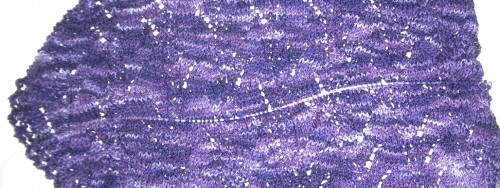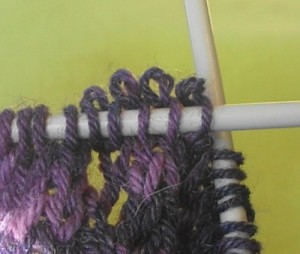READ ORIGINAL POST HERE
I ran out of yarn and cannot get more of the same yarn. The second point is missing. The Mallory Hills Shawlette would be unusable without that point.
After a week of mourning, here is how I fixed it:
- Calculate how many stitches are missing from the non-existent point. This is pretty simple using the charts and Excel. Approximately 1,168 stitches are missing. That gives me a target for how many stitches to remove from the central, point-forming area of the design.
- Calculate how many rows from the middle of the shawl would give me enough yarn to knit at least 1,168 stitches. Think in pairs of rows; you need to take out one row on each side of the center. Again, use charts and Excel. This lace pattern has mostly-purl WS rows, and that is a real help here, My calculation takes into account that I want the last complete row remaining after ripping out to be a WS row. This is challenging enough — make it easier where you can. Ripping back to Row 32 and resuming on Row 9 gives me enough yarn for 1,670 stitches. About 500 stitches’ worth for added security! Looking at the charts for the number of rows repeated in the three separate lace patterns, I can see that going from Row 32 to Row 9 will keep two of the three lace patterns consistent. Good visually! The pattern with a 48-row repeat simply cannot be matched this time. (References to row numbers should make sense when you read the pattern in Interweave Knitscene, Spring 2014.)
- Run a circular needle through stitches on target row, for me Row 32 nearest the middle of the shawl. Use a needle several sizes smaller than your working needle to make it easier. Don’t worry too much about getting every stitch perfect, though the more attention you give this step, the easier it will be later.
- Rip and wind yarn.
- Pay special attention to stitches on the needle and stitches that should be on the needle. It is a good idea to slip all stitches around the circular so you can examine each stitch. Un-twist twisted stitches. Any stitches missed can be picked up with a crochet hook. Stitches picked up
one row below where you meant to be can be re-created from the floats or recovered in the air. Stitches picked up one row above will stop the ripping; pick up on the correct row and continue to rip.
- Weigh the ball of yarn. Does it weigh at least half (ideally a little more than half) the full skein? If so, you are fine. If it weighs too little, you may need to rip out another two rows. If you have the choice, weigh grams rather than ounces.
- If ripping out after knitted fabric has sat a long time, block the yarn to get the kinks out. My shawl rested for only a week, and I did not see the need to block the yarn.
- Before beginning to knit again, compare stitches on the needle and the fabric to the chart. Does it look right? Do you have the correct number of stitches between pattern repeats? Ah…
- Resume knitting with your working needle size at the row that you calculated in Step 2. Set aside your smaller, life-line needle after your first row; you should not need it again for this project.
How might this have happened? I did a gauge swatch and thought I was on target for gauge, although we all know that a swatch is a sampling for a larger piece, and samples do not always predict full-scale results with perfect accuracy. The designer noted in the pattern that her sample “used almost all of one skein of yarn,” labeled at 490 yards. My skein of yarn is labeled 500 yards. According to the labels alone, I had 10 yards to spare. Yarn producers use averages. The designer’s skein might have had more than 490 yards, and the skein of yarn I have might actually be less than 500 yards. This just happens. It is not a flaw or a fault.
How might I have prevented running out of yarn on this project?
- Weighing the original ball, without its label, then weighing again near and not beyond the center of the shawlette to be sure I had not used more than half the yarn by weight. Adjust before knitting on.
- Using a smaller needle size than I used in the swatch, even though my swatch measured to gauge and had the drape and hand I wanted. When each stitch is a tiny bit smaller, you can knit more stitches with the same amount of yarn.
- Choosing a yarn for this pattern with well over 500 yards, either already in hand or available for purchase.
Aside from the added drama of ripping out more than half a lace shawl, I like this pattern. The photography in the magazine may not do it full justice, nor do these images of the un-blocked work in progress. The number and size of charts will appeal to dedicated lace knitters. The edge treatment is definitive and easy to work. Good pattern!
The yarn I am using is Miss Babs Tarte, fingering weight, 4-ply yarn with 75% superwash Merino, 15% nylon and 10% tencel. The purple color is a Babette called “Bubble Bath.” What’s a Babette? One-of-a-kind skeins, which you cannot expect ever to see again. I bought one skein at a festival and have not spotted a Raveler with the same colorway with whom I might trade. I like knitting with it and look forward to seeing how it blocks.
This fix works for this project but may not apply to all cases of running out of yarn, and knitters without a geeky streak will not want to use it at all. A similar strategy may work on other projects, especially when there is an obvious middle to the design and you can work out from there to create a new mid-point suited to the amount of yarn you have.
Would you use this method to eke out a shawl with less yarn than called for? What would you do instead if you had a lace shawl missing its second point?



No comments:
Post a Comment